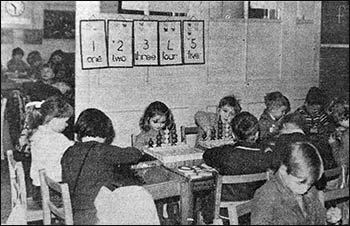South End Primary School, Rushden, which is 93 years old and has been described as the worst urban school in the county, is to be replaced – subject to negotiations between the County Council and hospital authorities for the purchase of land belonging to Rushden Hospital.
This news was announced at the county education committee meeting; the committee proposes to build additional classrooms and gradually replace the school on a site off Wymington Road.
The same day the committee received a petition from over 200 parents demanding that the school should be replaced. They claimed that the school, built in 1870, was in bad condition; there was overcrowding in the classrooms; the playground was uneven; toilet facilities were inadequate; and there were dangers to the children from A6 traffic.
Delighted
The petition was organised by Mrs. Rosemary Jones, of 31 Manor Road. About the county council’s £20,000 plan, she commented: “I was absolutely delighted when I heard I had no idea that they had anything like that in mind.”
Ald. Cyril Faulkner, Rushden urban councillor and member of the county education committee, described the school as one of the worst in Northamptonshire at the committee meeting. He has been pressing for some time for something to be done.
Ald. Faulkner told the “Echo” this week: “I don’t think there will be any difficulty now that the money has been officially included in the estimates.”
 |
|
Inside the primary school
|
The education committee plans will come before the county council next week for approval.
Ald. Faulkner said he felt the reason for the long delay in bringing South End School up to date was the “curious set-up” in the economy. Corby, he said, always had separate treatment in its estimates for spending on education – at the expense of the rest of the county.
The County Education Officer, Mr. G. E. Churchill, pointed out that the authorities had to do the best they could with the money allocated for school building and development.
“For years and years before the war schools were allowed to continue as they were. Now the education committee and Ministry have to try to catch up with the back-log of neglect,” he said.
Originally it had been hoped to extend the school on land adjacent to the present site, but the land was the subject twelve months ago of a public inquiry when the education committee asked for a compulsory purchase order to be placed on it. The result has yet to be announced.
The new school is to be built in instalments. The first section, which will include a central hall, classrooms, and cloakrooms, will eventually be added to until the 291 children at South End can be accommodated.
Mr. Churchill added that the education committee had already approached the regional hospital board about buying the land near Rushden Hospital, and was hoping for a favourable reply.
Additions
Since it was built in 1870 the South End School has had various additions; two wings, cloakrooms, an annexe, and three more classrooms. At present there are nearly 300 pupils on the rolls, and more are expected after Easter. The headmaster, Mr. F. C. Astle, has a staff of eight, which means there are between 31 and 40 children in each class – both infants and juniors.
Mr. Astle said: “The present school has physical limitations; there is not much space and this is often reduced as blackboards cannot be flush to the walls because of the pipes.”
Equipment
The school had all the equipment it wanted; desks, staff furniture, heating and lighting had all been installed or modernised since 1950, when he took up his appointment.
He blamed any overcrowding on the great influx of infants at starting age; there were 111 at present, and this number would be increased after Easter, when more pupils from the South End catchment area enrolled.
Other problems he and his staff had to contend with were separate assemblies – for the infants and juniors – because of lack of space; outside toilets, which often froze during cold weather; and what Mr. Astle described as “death-traps” – the projecting buttresses on the walls around the playground.